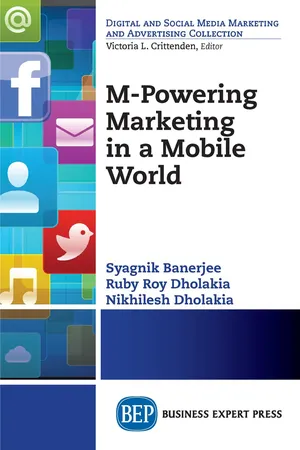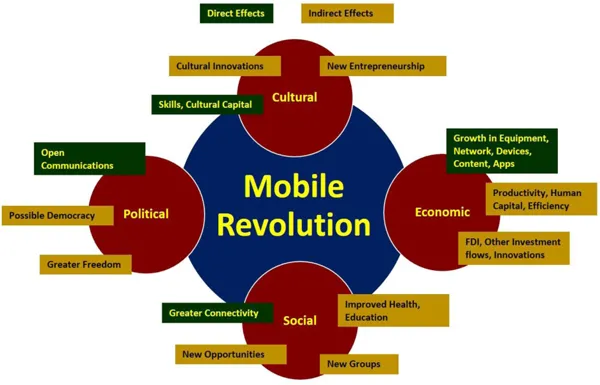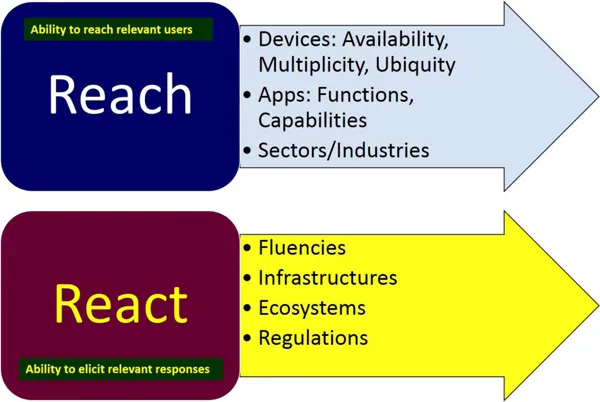![]()
CHAPTER 1
The Global Mobile Multiplier Effect
In 2014, the number of mobile phones in the world crossed the number of people on the planet. By 2015, almost 95 out of 100 adults in the world, including people in the poorest nations, had a mobile phone. By 2016, even smartphones were available to 2 billion people. In human history, no other technology has been able to achieve that—ever. The impacts of mobile technologies on our lives are profound, pervasive, and prompt. We need ways to grasp these impacts, so that we can cruise with the trends, rather than be crushed by these changes. From a business perspective, this book offers the conceptual framework and practical ways to act upon, and act with, the evolving mobile technology advantageously. Our aim is to offer a conceptual prism that helps make sense of complex, fast-paced mobile technology settings.
In this chapter, we begin with an overview of the changes that mobile technologies are bringing about all over the world—often in locations that one does not associate with advanced technologies. We next show how mobile technologies act as multipliers—with beneficial ripple effects in the economy and society. We present some ways of systematically understanding the evolution and interactions of mobile technologies.
The Amazing Ever-Morphing M-World
Mobile technology innovations, of course, are occurring, quite expectedly, in the advanced and affluent economies of North America, Europe, and parts of East Asia (especially in Japan, South Korea, Hong Kong, Taiwan, and Singapore). A somewhat surprising aspect of mobile technologies is that innovations are also occurring in developing countries whose vast populations may not have the resources to afford high-end, smart handheld (or wearable) devices or to subscribe to high-bandwidth data plans, but can afford basic mobile access. The big change that has happened is that basic mobile devices (and increasingly, even low-priced Chinese-made smartphones) and simple prepaid plans are now within the reach of even the poor of the planet. As we survey the mobile scene in 2017, here is a sampling of the innovations we observe:
- A mobile messaging app company founded in 2009 with only 55 employees, WhatsApp was acquired by Facebook in 2014 for the staggering sum of $19 billion. What made WhatsApp so valuable was its global footprint, reaching up to and over 90 percent of mobile users in many Asian, European, and Latin American countries. Although WhatsApp was founded in the United States and did its innovations in the United States, it employed an almost stealth approach of building a massive user base outside the United States.
- Watching the success of e-commerce on post-Thanksgiving Cyber Monday in the United States, China launched November 11 (or 11/11) as Singles Day for singles (as well as others) to buy online gifts—for themselves and others. From total sales of $5.14 billion in 2013, the Chinese firm Alibaba generated nearly $18 billion in sales in 2016, and 70 percent of the transactions were done on mobile phones.
- In the field of mobile payments, Kenya’s m-pesa has been a trailblazer, facilitating mobile phone-to-phone payments even with basic non-smartphones. Launched in 2007 by Safaricom (a Vodafone subsidiary), it made Kenya the world leader in mobile money systems.1 Not only do 17 million Kenyans use it, but also 25 percent of the gross national product of Kenya flows through it. One study found that in rural Kenyan households which adopted m-pesa, incomes increased by 5–30 percent. In addition, the availability of a reliable mobile payments platform has spawned a host of start-ups in the Kenyan capital city Nairobi, whose business models build on m-pesa’s foundations.2 Overall, m-pesa has been a true income multiplier for African countries. By 2017, via the resources of global telecom giant Vodafone, m-pesa had entered several countries in Asia and Europe. In Afghanistan, police officers discovered—to their pleasant surprise—that their salaries were 30 percent more via m-pesa phone payment system than what they were getting in cash, because corrupt officials could not siphon off any part of the electronic payment.
- Text To Change, an Amsterdam-based social enterprise that operates in Africa and South America, set up mobile-based awareness and educational programs through Short Messaging Service (SMS, or texting) for strengthening of school systems, communicating the best available agricultural prices to farmers, providing health care information, and increasing government accountability by making public expenditure data available transparently.
- Blindsquare has tackled the challenge of helping blind people navigate a city with the help of mobile social media. Blindsquare integrates the huge reservoir of crowdsourced Foursquare data with Apple’s native Voiceover technology to create a location-based virtual map through sound, to help blind pedestrians find locations on foot or while using public transportation. When the app is enabled, it reads addresses, street names, and surrounding locations aloud. Directions are available on demand.
- Ushahidi from Africa is a crowdsourcing platform built for crisis control, used in several emergencies for mapping location-based insights from text messages, and helping humanitarian groups engaged in rescue operations to pinpoint where and what kind of help is needed. Ushahidi has spread outside Africa also. For example, during the 2010 Haiti earthquake, crowdsourced messages on the Ushahidi platform quickly created interactive maps indicating the locations of maximum damage and where help was urgently needed.
- Abdou Maman Kané, a tech entrepreneur in Niger in Africa, developed an irrigation system powered mainly by solar power, to enable efficient and targeted irrigation of crops. The system can be operated remotely by any mobile phone by communicating with a SIM card installed in the control panel of the pumping and irrigating system.
- In BMW’s DriveNow carsharing program, cars use an embedded telematics unit to communicate their position via a Vodafone mobile-to-mobile or M2M SIM card. DriveNow cars are picked up, dropped off, or made available when and where needed. Members locate and reserve the nearest car via their mobile phones, unlocking the car using specially issued Radio Frequency ID or RFID tag.
- BMW’s arch-rival Mercedes-Benz has introduced the Car2Go program in Brooklyn, New York, with nearly 500 Smart brand cars, unlockable by the program subscribers using their mobile phones, ready to be driven for short distances at 40 cents-per-minute rental rate, and to be left at any legitimate parking space when done.
The above examples are just a sample of hundreds of mobile innovations occurring every month, in all parts of the globe—advanced nations as well as developing economies. Companies that are relying on mobile technology to build their businesses, especially if they want to be more than niche players, have to reach out to the 4-to-5 billion nonaffluent mobile users in the world. If they do not, they risk the possibility that emerging-economy-based, aggressively priced, competitive companies with vast developing-world user bases may begin to disrupt some of the high-priced, high-margin market segments in Western markets. The hoary truism—“there ain’t no brand loyalty that 2-cents-off won’t buy off”—holds very true in affluent markets where consumers often have been forced to be in expensive mobile service contracts and plans. There are distinct prospects of mobile innovators, especially from Asia, expanding into Western markets once they saturate their domestic markets. Slogans such as the “The Chinese are coming,” “The Mexicans are coming,” and “The Kenyans are coming” may turn from improbable jokes into real competitive threats. Even niche players in the affluent world face such threats, though in some strong niches, there may be potential to ward off low-cost competitors for a while. There is also a flip side to this. Personal fortunes and affluence are rising rapidly in many parts of the world, with millions of new middle-class households and thousands of super-rich households being created every month. The rising tide of affluence generates demand for high-end mobile products and services—and this has benefited topline players such as Apple and Samsung. In 2017, for example, tempted by the 300-million-and-growing user base of smartphone users in India, Apple announced plans to open its first iPhone manufacturing plant in that country. Thus, mobile tech revolutions are occurring at both ends—the premium-priced high end and the cut-throat-competitive low end of the market.
Mobile Multipliers: Economic and More
Mobile broadband has both direct and indirect effects on boosting the economy of a nation. Creating mobile telecom networks has direct impact on a country’s Gross Domestic Product or GDP via investments in networks, boosting orders from suppliers of equipment (network equipment as well as end-user devices), content and app creation, and more. Indirect effects of mobile telecom include increased productivity, human capital formation (in terms of increasingly skilled workers and entrepreneurs), stepping up Foreign Direct Investment (FDI), as well as portfolio stock market investments as investors worldwide sense opportunities and move investible funds to places where mobile telecommunications are growing. Whether it is farmers using mobile data services to sell their produce to end customers directly, tripling their revenue, or fisherfolk finding the best ports to unload their catches for maximizing the price received, mobile data multiplies productivity of the economy. Mobile connectivity also improves the quality of human capital—directly by making people more skilled in technology use, and indirectly by revolutionizing the state of health and education in developing economies. In some cases, children are learning grammar via SMS (texting) technologies. In other cases, telemedicine is allowing medical care to reach disconnected areas, where image transmission via mobile phones is helping diagnostics.
Figure 1.1 presents a simple schematic model of mobile multiplier effects. The direct effects are clearly visible and easy to trace. The indirect effects are diffused, often contingent on many other factors, but could—under appropriate conditions—be far more pervasive and powerful than the direct effects. The specific multiplier effects, of course, depend on the context. As mentioned, in Kenya and other parts of Africa, for example, multiplier effects of mobile payments are very pronounced, while in China and some East Asian nations, the effects in terms of virtual goods (game weaponry, avatar attires, virtual small gifts) and gaming applications are very noticeable.3
Figure 1.1 Schematic view of the mobile multiplier effects
Source: Authors’ conceptualization.
States of Mobile Evolution
All over the world, businesses—as well as governments and nongovernmental organizations (NGOs)—are on the lookout for ways to extend their reach and effectiveness via the use of mobile technologies. For any brand, agency, or marketer to initiate campaigns via mobile technologies, it is useful to think in terms of a Reach and React framework (see Figure 1.2).
Figure 1.2 The reach-react framework for effectiveness of mobile outreach methods
Source: Authors’ conceptualization.
The Reach dimension encompasses factors that determine how mobile-reliant organizations—companies, government agencies, or NGOs—can effectively reach out to their target constituencies. For example, brand marketers and advertisers may want to reach effectively their intended markets. A child welfare-oriented NGO may want to zero-in on children in need, be they in families or (in strife-ridden settings) in camps or group homes.
The React dimension identifies factors that determine to what extent consumers (or other types of users) can respond to marketing messages (or socially-oriented messages, in case of NGOs). Table 1.1 elaborates on each of the key factors within the overall Reach and React dimensions.
Table 1.1 Key factors in the reach and react dimensions
Source: Authors’ conceptualization.
Mobile Technologies and Supply Chains
Mobile technologies are leveling the playing field in terms of tracking and managing long supply chains, for goods as well as services. In the past, large multinational firms such as PepsiCo, Coca-Cola, Unilever, and Procter & Gamble were able to deploy systems to track their supply chains deep into the field. Such firms invested in expensive fleet telematics solutions, which generally included in-cab displays, on-board computers, and satellite communications—the cost per vehicle often exceeding $5,000. Only such giant consumer products multinational companies could justify the cost of such dedicated fleet telematics solutions. Of course, such capabilities continue to be very important for firms where logistics capabilities represent the lifeblood of the organization. For example, UPS has command centers tracking the company’s fleets that are often more sophisticated than the advanced command centers of many national militaries, and a mapping system that is far more accurate than Google Maps. By 2017, some UPS trucks were being equipped with drones, for deliveries to remote and off-route locations.
Under the older fleet telematics systems, the small firm with five trucks was left out of the loop. Widely available mobile devices, however, have enhanced shipment visibility across supply chains worldwide, and made the process more affordable for all. With the turnpike fleet optimization device from XRS Corporation (acquired by Omnitracs in 2014), onboard computer capabilities can be achieved with just $30–$50 a month per vehicle. The size of a deck of playing cards, the onboard device is powered by a cable connector and uses Bluetooth to communicate with handheld devices. For example, an NGO called Food Cowboy uses XRS as well as other mobile technologies to first locate surplus (but still usable and edible) food at wholesalers and restaurants, and then, divert such food away from dumpsters and landfills, to grateful food banks and soup kitchens.
Supply chains of services are also get...



